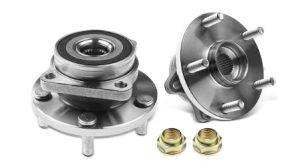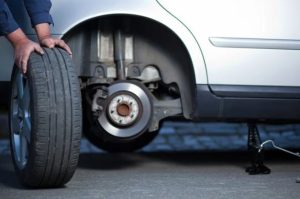Your vehicle’s wheel hubs and bearings are among the most critical — yet often overlooked — components of the suspension and drivetrain system. They support the weight of your car, allow the wheels to spin smoothly, and play a crucial role in safety, handling, and ride comfort. When a hub assembly or wheel bearing starts to fail, the consequences can escalate quickly, leading not only to costly repairs but also serious safety risks.
Recognizing the early warning signs of hub failure allows you to address the problem before it leads to wheel lock-up, brake damage, or even complete loss of control. In this guide, we’ll explore the most common symptoms, how to diagnose them, and what steps to take next.
Why Hub and Bearing Health Matters

The wheel hub assembly connects the wheel to the axle and often contains the wheel bearing itself. Together, they ensure low-friction wheel rotation while supporting the vehicle’s weight and absorbing road forces.
If a hub or bearing begins to degrade, it can affect steering precision, braking efficiency, fuel economy, and even tire wear. More importantly, advanced failure can cause the wheel to wobble or detach — a catastrophic scenario that can occur without warning if early symptoms are ignored.
Common Early Warning Signs of Hub Failure
Below are the most frequent indicators that your hub assembly or bearing is nearing the end of its life. If you notice any of these, it’s time to inspect or replace the component immediately.
Unusual Noises
A failing hub or bearing often produces grinding, humming, or growling noises, especially at higher speeds.
-
Grinding or rumbling: Often indicates metal-on-metal contact inside the bearing.
-
Humming or droning: May get louder when turning, pointing to uneven wear.
-
Clicking or snapping: Can occur during acceleration or turning, suggesting loose internal components.
Vibration and Steering Play
If you feel vibrations through the steering wheel or a “loose” sensation when driving, this can signal bearing wear or hub looseness. Such vibrations often intensify with speed and can lead to steering instability if not addressed.
Uneven or Rapid Tire Wear
Because a failing hub affects wheel alignment and rotation, tires may wear unevenly or much faster on one side. If you notice abnormal tread wear, check the hub assembly before replacing the tires.
ABS Warning Light
Modern vehicles integrate the ABS sensor into the hub assembly. A failing bearing can disrupt sensor signals, triggering the ABS warning light. This is an early electronic indicator that shouldn’t be ignored.
Pulling to One Side or Braking Issues
If your car pulls to one side while driving or braking, or if braking feels inconsistent, hub or bearing wear could be a hidden cause. This happens due to improper wheel alignment or increased friction.
Excessive Wheel Play or Wobble
When the vehicle is lifted, try rocking the wheel by hand. Any noticeable looseness or “play” often indicates internal bearing damage or a failing hub assembly.
Diagnostic Tips for Drivers and Mechanics
Here’s a quick table to help you match symptoms with potential causes:
| Symptom | Possible Cause | Recommended Action |
|---|---|---|
| Grinding or rumbling noise | Bearing wear or internal damage | Replace hub/bearing immediately |
| ABS light activated | Faulty sensor or damaged hub assembly | Inspect hub assembly and sensor connections |
| Steering vibration | Loose bearing, hub damage, or misalignment | Check wheel torque, inspect hub |
| Uneven tire wear | Bearing play or incorrect wheel angle | Inspect suspension and hub |
| Wheel wobble when lifted | Severe bearing wear or loose hub | Immediate replacement required |
Factors That Accelerate Hub Wear
While hubs and bearings are built to last tens of thousands of kilometers, certain conditions can significantly reduce their lifespan:
-
Frequent driving on rough roads: Increases mechanical stress and impact damage.
-
Improper wheel installation: Over- or under-torquing wheel nuts can damage bearings.
-
Exposure to water, dirt, and salt: Accelerates corrosion and reduces lubrication efficiency.
-
Heavy loads or towing: Adds stress beyond the bearing’s design limits.
-
Neglecting suspension maintenance: Worn suspension parts can increase hub load.
Prevention and Maintenance Tips
Keeping your hub and bearing system healthy doesn’t require major effort — just consistent care:
-
Inspect hubs regularly (every 20,000–30,000 km) for noise, play, or leaks.
-
Avoid power-washing directly on hub seals to prevent water intrusion.
-
Check wheel torque after tire changes or rotations.
-
Replace bearings in pairs (both front or both rear) for balanced wear.
-
Use quality parts from trusted suppliers to ensure proper fit and longevity.
When to Replace the Hub Assembly

If any of the symptoms above are present — especially grinding noises, ABS issues, or noticeable wheel play — replacement is often the safest choice. Continuing to drive on a failing hub risks further damage to the suspension, brakes, and even the axle.
For reliable replacement parts, you can Buy Wheel Hub & Bearings online and choose from a wide range of OEM-quality components suitable for various vehicle models.
Final Thoughts
Wheel hub failure rarely happens suddenly — most issues give off plenty of warning signs well before a dangerous situation arises. Ignoring grinding noises, steering vibrations, or ABS warnings may lead to severe damage and safety risks. By paying attention to these early indicators and performing timely inspections, you can extend the life of your vehicle’s suspension system, improve ride quality, and ensure safe, reliable driving.
Don’t wait until a bearing seizes or a wheel wobbles dangerously — address hub problems early and keep your vehicle performing at its best.